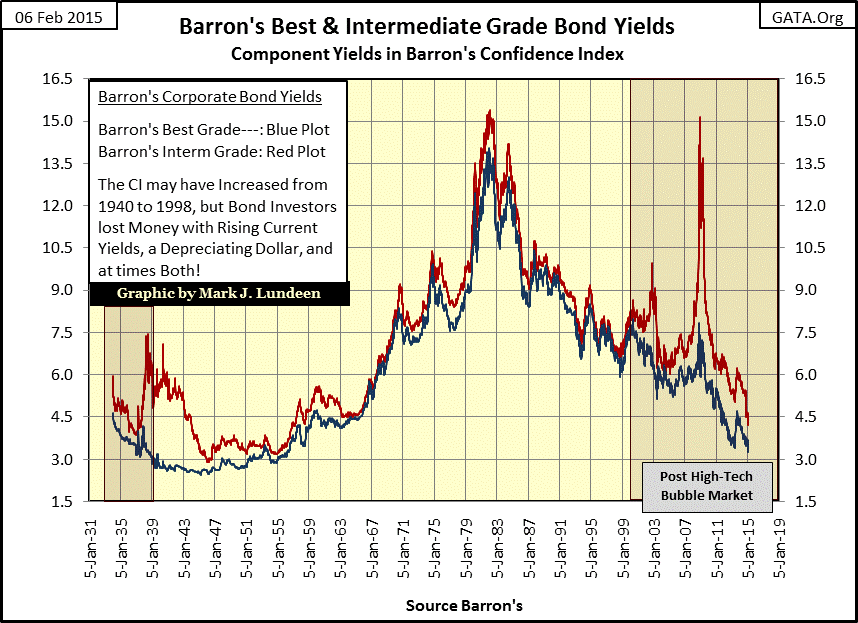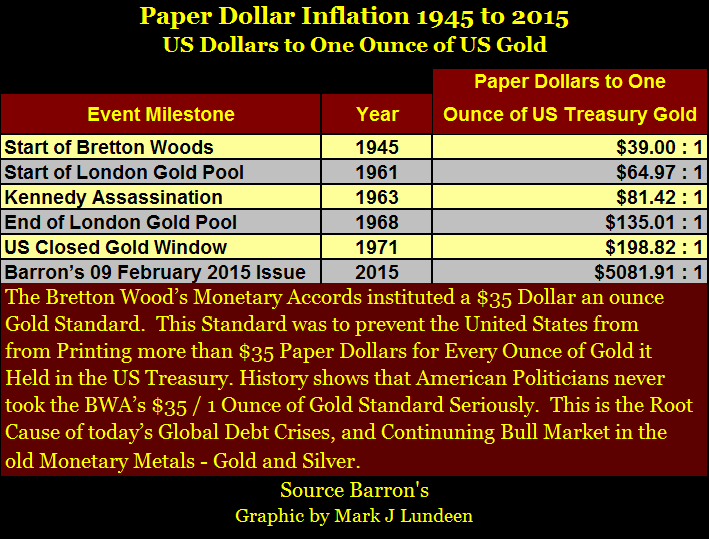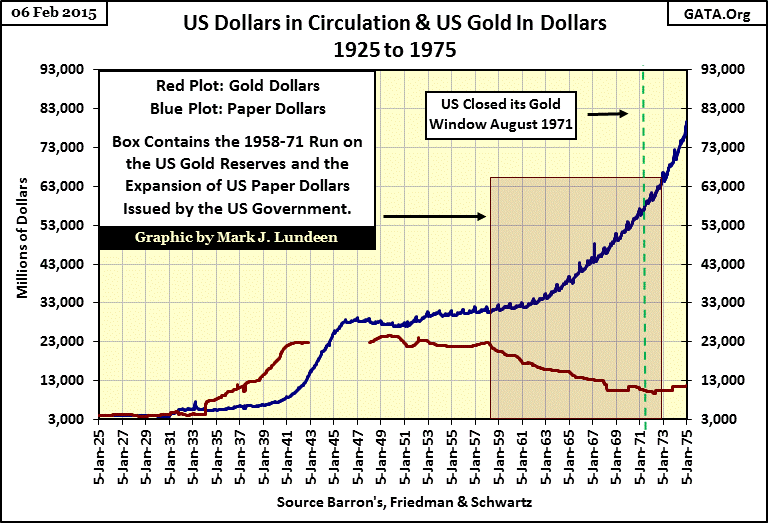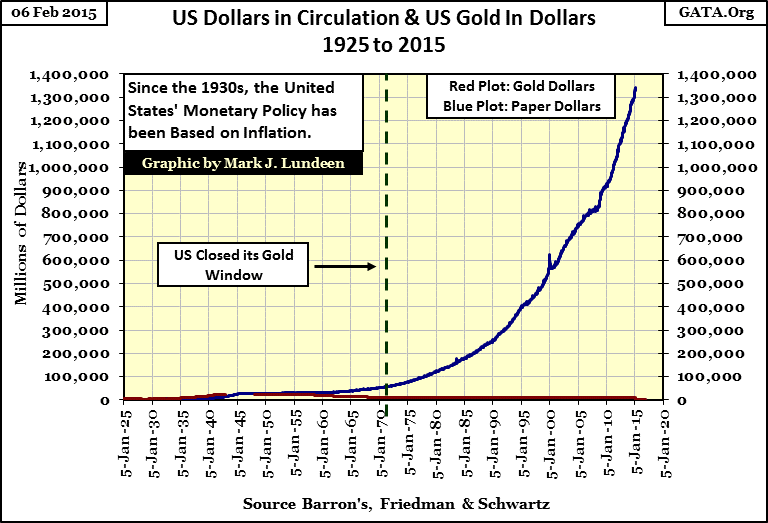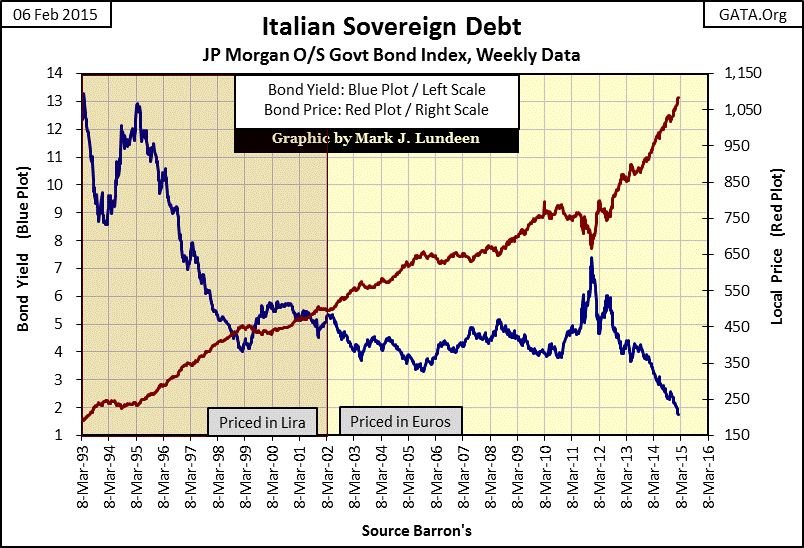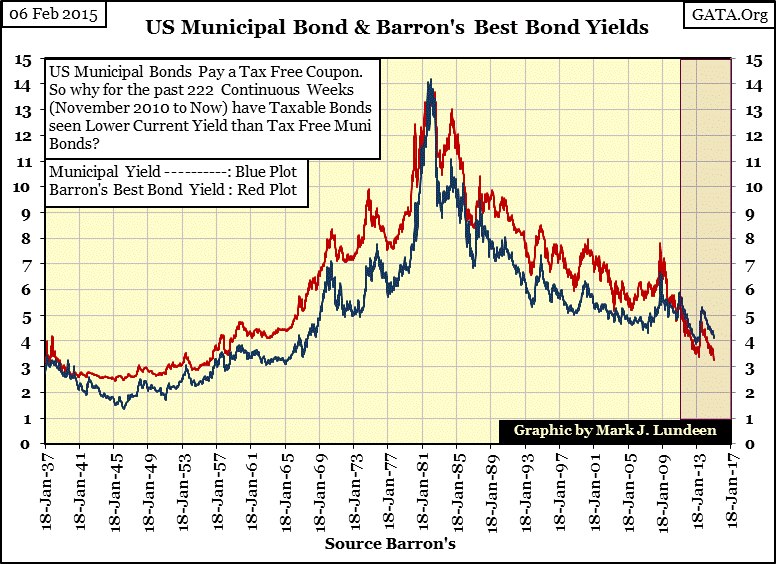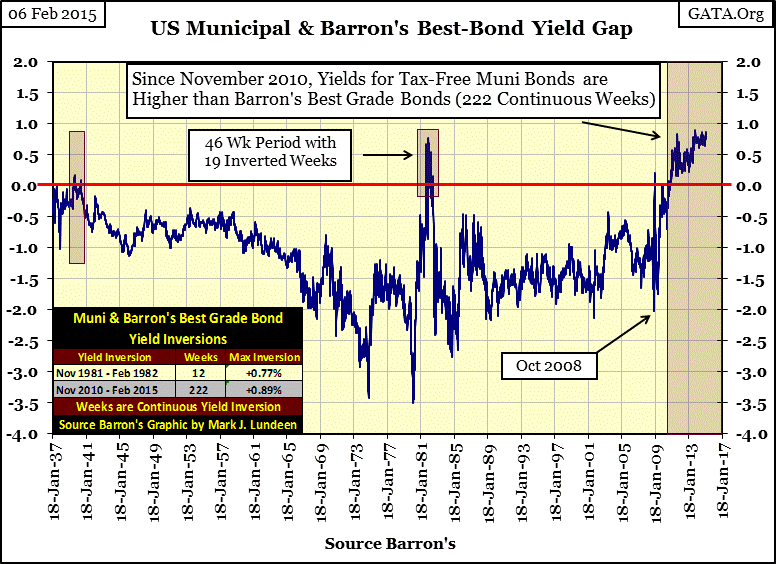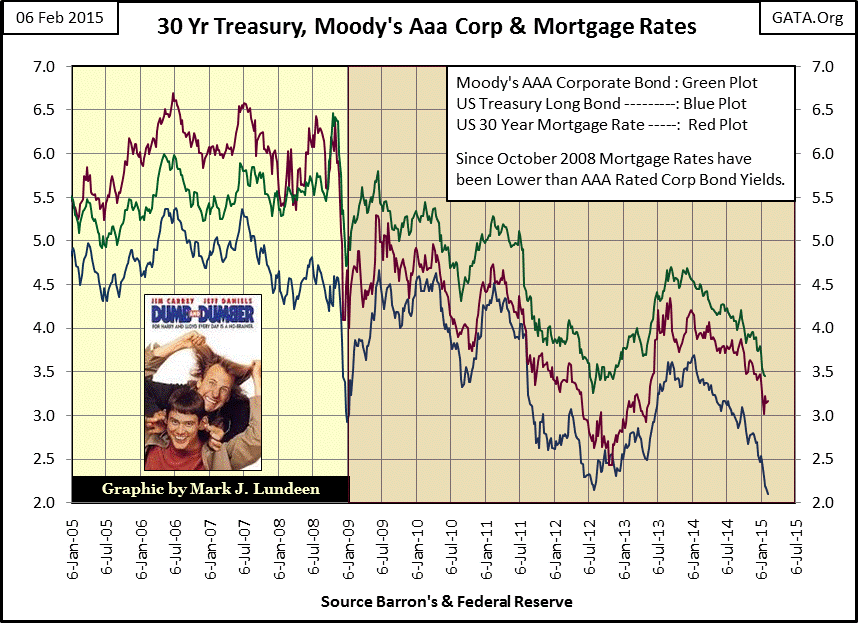A Look At Bond Yields 1934 To 2015
Barron’s Best & Intermediate Grade Bond Yields provides us with an excellent history of investment grade bond yields from December 1938 when Barron’s first computed its Confidence Index (CI). I reconstructed these two bond series going back to 1934 (Red Box) using tables published in Barron’s. My reconstruction is a good one; we see Barron’s Intermediate Bond Yields rising up in 1937 in response to economic dislocations that came about at this time during the Great Depression, which was exactly what one would have expected.
What made the 1930s so depressing was counter-party failure. During the Roaring 1920s, easy money flowing from the Federal Reserve ultimately flowed into ill-considered business ventures which obtained financing only because the Fed made the money available. These enterprises were ultimately doomed to fail, but not before they had flooded the bond market with fixed income instruments sporting “attractive yields.” Then as now, these bonds found their way into private portfolios, insurance companies and trust funds, all on the advice of “investment professionals.” When Mr Bear initiated his “stress test” of the bond market in the early 1930s, many bonds that were presumably investment grade went into default, making poor people out of the formerly rich. Fear of default in anything less than best grade bonds during the Great Depression took years to calm, which is why it took a full decade (1937-46) for intermediate grade yields to once again decline towards best grade yields.
A devastating thirty-year bear market in bonds began after World War Two, three decades which saw bond yields soar to double-digits from around 3%. Unlike the depressing 1930s, this bond debacle wasn’t from counter-party failure, but as a result of US “monetary policy.” The Bretton Woods Monetary Accords, an international monetary treaty ratified and signed into law in 1945 stipulated that America would never issue more than $35 paper dollars for each ounce of gold bullion held by the US Treasury.
However American “policy makers” soon began ignoring the law by gradually issuing more paper dollars than they had gold to back. By the time the US Treasury finally was forced to close the gold window in August of 1971, the fiction of $35 gold ended because the US government had issued 199 paper dollars for every ounce of gold held by the US Treasury. Currently there are 5,082 paper dollars for each ounce of gold the US Treasury claims to hold.
This violation of law (the Bretton Woods Accords) was done blatantly and openly. Since the 1930s, the US Treasury and Federal Reserve have issued weekly US gold reserves and Currency in Circulation (CinC) statistics, which Barron’s dutifully published. The chart below makes apparent the growing gap between the growth in paper dollars in circulation (Blue Plot) and the US gold reserves (Red Plot) seen since the early 1950s corresponding with the rising bond yields we see in the chart above.
By 1958 paper money inflation had finally created a run on US gold reserves, driving bond yields still higher. The US “closed the gold window” in August 1971; the second time since the creation of the Federal Reserve in 1913 the US Treasury had refused to redeem its paper money with treasury gold, as stipulated by law. In the face of this avalanche of monetary inflation US consumer prices began to rise at double-digit rates by the 1970s, and so did bond yields. When bond yields ultimately peaked in October 1981, it marked the start of a bond-bull market that has continued to this day. But considering the horrendous monetary inflation seen in the chart below, one has to wonder how a bull market in bonds (steadily declining yields since 1981) is even possible?
Back in 1981, we had double digit US Treasury bond yields in an economy beginning to see a reduction in Consumer Price Inflation. This made bonds not only an excellent source of income (yielding above the rate of inflation for the first time since the 1950s), but an excellent source of capital gains. But that was three decades ago. With today’s global economy drowning in unserviceable debt created by central banks, bond prices and yields are dangerously in bubble territory. And as was the case during the Roaring 1920s boom time, the fixed income market is once again pregnant with counter-party risk.
The problem is worldwide and only growing worse. Here’s a chart for Italian sovereign debt going back to 1993. During the first half of the 1990s the Italian government had to pay double digit rates to its creditors (when these bonds were priced in lira), which was good since these high yields prevented Italy’s politicians from foolish overspending. However when Italian debt was re-priced in euros in March 2002, bond yields declined dramatically since everyone knew that the new euro would have the strength of the old Deutsche Mark, while euro-denominated government bonds would be just as risk free as US Treasuries.
Events of the past few years have dampened Euro-Zone euphoria. Still, as of last week the yield on Italian government bonds was actually lower than the ten year US Treasury. That isn’t so much an issue with me, as A far bigger issue to me is why aren’t both US and Italian sovereign bonds currently yielding well over 10%? Both governments are bankrupt morally as well as financially, but yields on their bonds are somehow kept miraculously low. No mystery in this; central banks are supporting government bond markets in order to preserve the appearance of solvency. Central banks are also protecting their banking systems from becoming overwhelmed by hundreds of trillions of dollars in claims on interest rate derivatives should bond yields rise.
It’s hard to find good news anywhere in the bond market; the US municipal bond market has been waving a big-red flag for years. Muni-bond are issued by local and state governments. They pay an income tax free coupon, and are serviced by local taxes, making them a favorite safe investment for wealthy individuals seeking income. However, yields for muni-bonds (Blue Plot) have traditionally been lower than those of similar quality taxable corporate bonds (Red Plot), as seen in the chart below.
But since 1937 there have been exceptions to that general rule, times when yields for muni-bond were higher than similar grade corporate bonds. The credit spread between Barron’s Best Grade and Muni-Bond yields shown below highlights the three periods since 1937 when tax-free income from the bond market was actually higher than taxable income, and in all three instances this inversion signaled distress in the finances of local and state governments.
The first yield inversion in Barron’s data set occurred at the tail-end of the Great Depression in 1939 & 1940. The second time came about as Paul Volker jacked short term interest rates up to double digits in the late 1970s and early 1980s, but both these episodes of inverted muni-bond yields were short in duration. The current muni-bond yield inversion has become chronic, continuing for an astounding 222 weeks as seen in the red box to the far right.
There is something very wrong with a market where wealthy people seeking income will forgo a 30% tax incentive, plus seventy additional basis points in yield, choosing instead to take their chances in the taxable corporate bond market. Public finance at the local and state government must be having problems the financial media is not aware of, but evident enough to muni bond buyers.
There are strange things occurring in the mortgage market as well, where we see mortgage rates (Red Plot below) falling below those of Moody’s Aaa corporate bond yields (Green Plot) ever since late 2008 (as the mortgage crisis was approaching its peak). In fact since January 2009, there have been times when mortgage rates were almost identical to the US Treasury’s 30 year bond yield (Blue Plot).
How could that be explained? Simply enough; bond yields are no longer set by risk and reward factors, but by Dumb and Dumber over at the Federal Reserve. Unfortunately, the entire global bond market is now an anachronism, a relic from the gold standard whose primary use today is to generate fees and commissions for Wall Street banks in total disregard of the best interest of their clients. These titans-of-finance have a proven record of having no concern for anyone other than themselves. In a world such as ours, there is something to be said for holding physical gold and silver.






